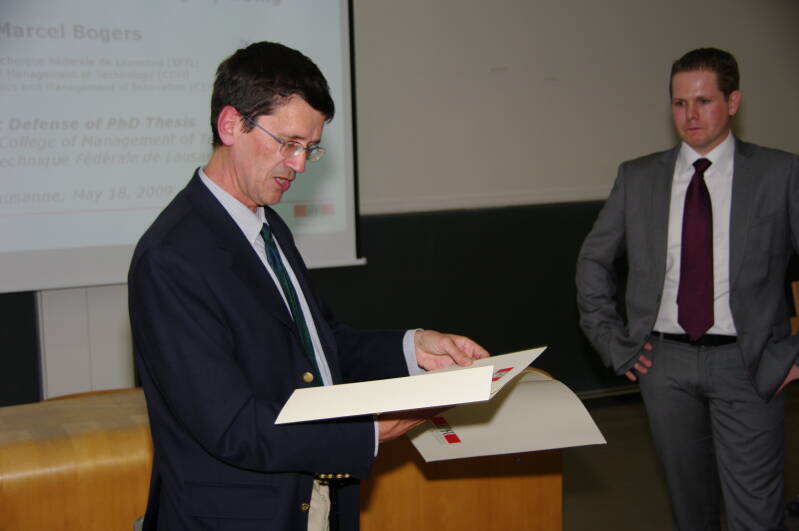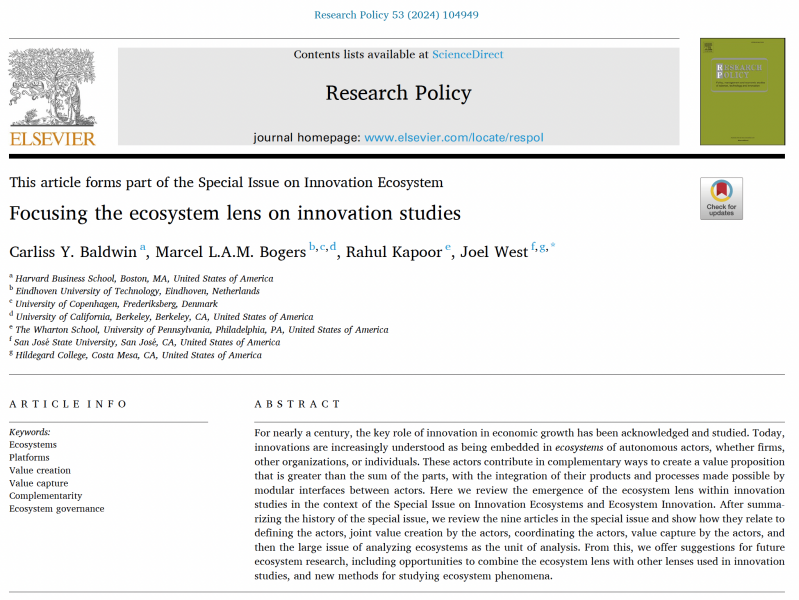The announcement of the 2025 Nobel Prize in Economics brought welcome recognition to a concept that has been central to innovation studies for decades: creative destruction. The prize was awarded to Joel Mokyr of Northwestern University, Philippe Aghion of INSEAD, and Peter Howitt of Brown University for their groundbreaking work explaining innovation-driven economic growth.
While the prize is firmly rooted in economics, it resonates deeply with those of us working in innovation management. The concept of creative destruction—how new innovations systematically replace older technologies and business models—provides a crucial bridge between economic theory and management practice. It's a reminder that the boundaries between these disciplines are far more porous than academic silos might suggest.
Schumpeter's Enduring Influence
Joseph Schumpeter introduced the term 'creative destruction' in his 1942 book Capitalism, Socialism, and Democracy, describing it as the process through which capitalism 'incessantly revolutionizes the economic structure from within, incessantly destroying the old one, incessantly creating a new one.' This dynamic process, he argued, was 'the essential fact about capitalism.'

What makes this concept so powerful is its recognition that innovation is not merely additive but fundamentally transformative. The steam engine didn't just supplement human and animal power—it revolutionized manufacturing and transportation. Digital technologies haven't simply enhanced existing business models—they've created entirely new ones while rendering others obsolete. This perspective has profoundly influenced management scholars studying innovation.

Picture: Joseph Schumpeter
The management literature has extensively built upon Schumpeterian foundations. Key works include David Teece's seminal 1986 paper on profiting from technological innovation, which explored the conditions under which innovating firms capture value—a critical complement to understanding creative destruction—, and Clayton Christensen's work on disruptive innovation, published in the Harvard Business Review and later expanded in The Innovator's Dilemma. These scholars, among many others, have helped translate Schumpeter's economic insights into actionable frameworks for managers navigating technological change.
The Evolutionary Economics Foundation
My own intellectual journey into innovation studies was deeply shaped by the evolutionary economics tradition that emerged in the 1970s and 1980s. This paradigm, which combines Schumpeter's insights with the behavioral theory of the firm, provided the theoretical foundation for much of my doctoral work at EPFL.
At the heart of this tradition stands the monumental 1982 book by Richard Nelson and Sidney Winter, An Evolutionary Theory of Economic Change. This work revolutionized our understanding of how firms learn, adapt, and compete in dynamic environments. Nelson and Winter's emphasis on organizational routines, bounded rationality, and path-dependent innovation processes provided a rich framework for understanding innovation management that went far beyond traditional equilibrium-based economic models.
It's worth noting that Richard Nelson, who sadly passed away on January 28, 2025, at the age of 94, was himself frequently mentioned as a strong candidate for the Nobel Prize. Many in the field believed he and Winter deserved the recognition for their contributions to evolutionary economics. I had the privilege of meeting Nelson during a workshop at EPFL during my PhD years. One particularly memorable moment occurred during a coffee break when we happened to take a bio break at the same time and ended up discussing the social construction of toilets—a testament to the intellectually stimulating and wonderfully eclectic environment that characterized my time at EPFL.
From Theory to Practice: My PhD Journey
Under the supervision of Dominique Foray at EPFL, my doctoral research was firmly rooted in this evolutionary tradition. Foray's work on the economics of knowledge and innovation provided an invaluable foundation for understanding how knowledge creation and diffusion drive economic change. The influence of evolutionary thinking extended through my Master's thesis as well, where I was supervised by Ove Granstrand at Chalmers University of Technology and Rudi Bekkers of Eindhoven University of Technology. They all brought deep expertise in evolutionary economics to their work.
Several key concepts from this tradition proved particularly influential in shaping my understanding of innovation dynamics. Beyond creative destruction itself, I explored punctuated equilibrium—the pattern of long periods of incremental change interrupted by radical discontinuities—and diffusion of innovation, examining how new technologies and practices spread through populations and organizations. These frameworks helped me make sense of the complex, non-linear patterns we observe in real innovation processes.

Picture: Public defense PhD Marcel Bogers at EPFL (18 May 2009)
Bridging to Open Innovation
The evolution of my research interests naturally led to the field of open innovation, where concepts of creative destruction take on new dimensions. Henry Chesbrough's open innovation paradigm, introduced in 2003, challenged the traditional closed innovation model by showing how firms can and should leverage external sources of knowledge while also allowing their own knowledge to flow outward.
The connection between creative destruction and open innovation becomes apparent when we consider how innovation ecosystems operate. In modern innovation environments, creative destruction doesn't just happen within firm boundaries—it occurs across networks of companies, universities, startups, and other actors. Open innovation practices both accelerate and are accelerated by this process. When firms open their boundaries to external knowledge, they participate more actively in the broader creative destruction occurring in their industries and markets.
My recent work on innovation ecosystems, with Carliss Baldwin, Rahul Kapoor, and Joel West, published in Research Policy, extends this rich intellectual tradition to examine how value creation and capture occur across networks of actors in contemporary innovation systems. We've explored how ecosystem actors create complementary value, how they coordinate innovation activities, and how value is captured and distributed. These questions echo Schumpeter's fundamental concerns about innovation and competition, but situated in the more networked, distributed innovation systems that characterize the 21st century.
Picture: Front page of Research Policy article on 'Focusing the ecosystem lens on innovation studies'
Why This Prize Matters
The 2025 Nobel Prize in Economics matters not just because it recognizes important theoretical contributions, but because it validates the Schumpeterian perspective that has animated so much innovation research across disciplines. Mokyr, Aghion, and Howitt have provided both historical depth and mathematical rigor to our understanding of how innovation drives growth and how creative destruction works at the macro level.
For those of us working in innovation management, this recognition serves as an important reminder of the deep intellectual roots of our field. The concepts we use to understand firm strategy, technology adoption, ecosystem dynamics, and open innovation all trace back, in one way or another, to Schumpeter's insights about creative destruction. The prize also highlights the continuing relevance of these ideas in an era of accelerating technological change, from artificial intelligence to biotechnology to clean energy.
As the Nobel committee noted in their announcement, economic growth cannot be taken for granted. We must uphold the mechanisms that underlie creative destruction while managing its disruptive effects on workers and communities. This dual challenge—fostering innovation while addressing its social consequences—remains as relevant in management practice as it is in economic policy.
Looking Forward
The awarding of the Nobel Prize for work on creative destruction comes at a particularly apt moment. We are living through a period of rapid technological transformation, with AI, climate technologies, and biotechnology creating new waves of creative destruction. Understanding these dynamics—how innovation emerges, diffuses, and disrupts existing arrangements—is more important than ever.
For innovation scholars and practitioners alike, this prize reaffirms that the questions Schumpeter raised almost a century ago remain central to our work. How do we foster innovation while managing its disruptive effects? How do firms and economies adapt to technological change? How can we ensure that creative destruction generates broadly shared prosperity rather than concentrated gains and losses? These are not just academic questions—they are fundamental challenges for organizations, policymakers, and societies.
The Nobel Prize reminds us that great ideas transcend disciplinary boundaries. Creative destruction is simultaneously an economic concept, a management framework, and a lens for understanding social and technological change. As we continue to study innovation in all its forms—from open innovation to ecosystem innovation to digital transformation—we build on foundations laid by Schumpeter, Nelson, Winter, and now honored through Mokyr, Aghion, and Howitt.
The conversation between economics and management, between theory and practice, continues. And that ongoing dialogue, much like innovation itself, creates new insights while building on what came before—a kind of intellectual creative destruction that advances our collective understanding of how innovation works and how we can harness it for human progress.

Marcel Bogers is a Full Professor of Open & Collaborative Innovation at the Eindhoven University of Technology and a Research Fellow at the University of California, Berkeley.
He speaks, writes, and advises on how organizations can create and capture value through openness and collaboration.
Blog posts written with some help of AI! 🙂

Add comment
Comments